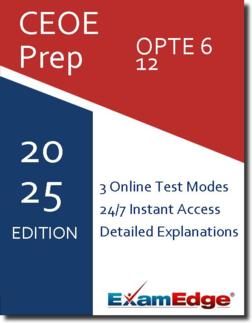CEOE OPTE 6-12 (76) Practice Tests & Test Prep by Exam Edge - Topics
Based on 40 Reviews
- Real Exam Simulation: Timed questions and matching content build comfort for your CEOE OPTE 6-12 test day.
- Instant, 24/7 Access: Web-based CEOE Oklahoma Professional Teaching Examination 6-12 practice exams with no software needed.
- Clear Explanations: Step-by-step answers and explanations for your CEOE exam to strengthen understanding.
- Boosted Confidence: Reduces anxiety and improves test-taking skills to ace your CEOE Oklahoma Professional Teaching Examination 6-12 (76).

Understanding the exact breakdown of the CEOE Oklahoma Professional Teaching Examination 6-12 test will help you know what to expect and how to most effectively prepare. The CEOE Oklahoma Professional Teaching Examination 6-12 has 75 multiple-choice questions and 3 essay questions. The exam will be broken down into the sections below:
| CEOE Oklahoma Professional Teaching Examination 6-12 Exam Blueprint | ||
|---|---|---|
| Domain Name | % | Number of Questions |
| Learners and Learning | 24% | 18 |
| Instructional Practice | 28% | 21 |
| The Professional Environment | 18% | 14 |
| Constructed-Response | ||
| Learners and Learning | 10% | 8 |
| Instructional Practice | 10% | 8 |
| The Professional Environment | 10% | 8 |


